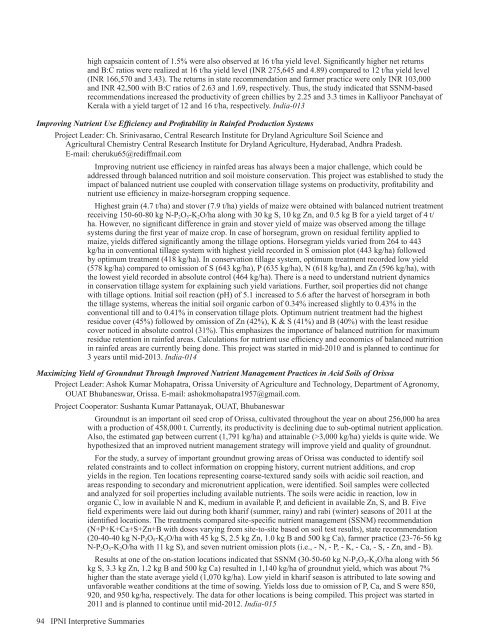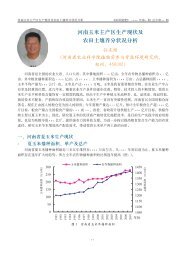Americas and Oceania Group - International Plant Nutrition Institute
Americas and Oceania Group - International Plant Nutrition Institute
Americas and Oceania Group - International Plant Nutrition Institute
Create successful ePaper yourself
Turn your PDF publications into a flip-book with our unique Google optimized e-Paper software.
high capsaicin content of 1.5% were also observed at 16 t/ha yield level. Significantly higher net returns<br />
<strong>and</strong> B:C ratios were realized at 16 t/ha yield level (INR 275,645 <strong>and</strong> 4.89) compared to 12 t/ha yield level<br />
(INR 166,570 <strong>and</strong> 3.43). The returns in state recommendation <strong>and</strong> farmer practice were only INR 103,000<br />
<strong>and</strong> INR 42,500 with B:C ratios of 2.63 <strong>and</strong> 1.69, respectively. Thus, the study indicated that SSNM-based<br />
recommendations increased the productivity of green chillies by 2.25 <strong>and</strong> 3.3 times in Kalliyoor Panchayat of<br />
Kerala with a yield target of 12 <strong>and</strong> 16 t/ha, respectively. India-013<br />
Improving Nutrient Use Efficiency <strong>and</strong> Profitability in Rainfed Production Systems<br />
Project Leader: Ch. Srinivasarao, Central Research <strong>Institute</strong> for Dryl<strong>and</strong> Agriculture Soil Science <strong>and</strong><br />
Agricultural Chemistry Central Research <strong>Institute</strong> for Dryl<strong>and</strong> Agriculture, Hyderabad, Andhra Pradesh.<br />
E-mail: cheruku65@rediffmail.com<br />
Improving nutrient use efficiency in rainfed areas has always been a major challenge, which could be<br />
addressed through balanced nutrition <strong>and</strong> soil moisture conservation. This project was established to study the<br />
impact of balanced nutrient use coupled with conservation tillage systems on productivity, profitability <strong>and</strong><br />
nutrient use efficiency in maize-horsegram cropping sequence.<br />
Highest grain (4.7 t/ha) <strong>and</strong> stover (7.9 t/ha) yields of maize were obtained with balanced nutrient treatment<br />
receiving 150-60-80 kg N-P 2 O 5 -K 2 O/ha along with 30 kg S, 10 kg Zn, <strong>and</strong> 0.5 kg B for a yield target of 4 t/<br />
ha. However, no significant difference in grain <strong>and</strong> stover yield of maize was observed among the tillage<br />
systems during the first year of maize crop. In case of horsegram, grown on residual fertility applied to<br />
maize, yields differed significantly among the tillage options. Horsegram yields varied from 264 to 443<br />
kg/ha in conventional tillage system with highest yield recorded in S omission plot (443 kg/ha) followed<br />
by optimum treatment (418 kg/ha). In conservation tillage system, optimum treatment recorded low yield<br />
(578 kg/ha) compared to omission of S (643 kg/ha), P (635 kg/ha), N (618 kg/ha), <strong>and</strong> Zn (596 kg/ha), with<br />
the lowest yield recorded in absolute control (464 kg/ha). There is a need to underst<strong>and</strong> nutrient dynamics<br />
in conservation tillage system for explaining such yield variations. Further, soil properties did not change<br />
with tillage options. Initial soil reaction (pH) of 5.1 increased to 5.6 after the harvest of horsegram in both<br />
the tillage systems, whereas the initial soil organic carbon of 0.34% increased slightly to 0.43% in the<br />
conventional till <strong>and</strong> to 0.41% in conservation tillage plots. Optimum nutrient treatment had the highest<br />
residue cover (45%) followed by omission of Zn (42%), K & S (41%) <strong>and</strong> B (40%) with the least residue<br />
cover noticed in absolute control (31%). This emphasizes the importance of balanced nutrition for maximum<br />
residue retention in rainfed areas. Calculations for nutrient use efficiency <strong>and</strong> economics of balanced nutrition<br />
in rainfed areas are currently being done. This project was started in mid-2010 <strong>and</strong> is planned to continue for<br />
3 years until mid-2013. India-014<br />
Maximizing Yield of Groundnut Through Improved Nutrient Management Practices in Acid Soils of Orissa<br />
Project Leader: Ashok Kumar Mohapatra, Orissa University of Agriculture <strong>and</strong> Technology, Department of Agronomy,<br />
OUAT Bhubaneswar, Orissa. E-mail: ashokmohapatra1957@gmail.com.<br />
Project Cooperator: Sushanta Kumar Pattanayak, OUAT, Bhubaneswar<br />
Groundnut is an important oil seed crop of Orissa, cultivated throughout the year on about 256,000 ha area<br />
with a production of 458,000 t. Currently, its productivity is declining due to sub-optimal nutrient application.<br />
Also, the estimated gap between current (1,791 kg/ha) <strong>and</strong> attainable (>3,000 kg/ha) yields is quite wide. We<br />
hypothesized that an improved nutrient management strategy will improve yield <strong>and</strong> quality of groundnut.<br />
For the study, a survey of important groundnut growing areas of Orissa was conducted to identify soil<br />
related constraints <strong>and</strong> to collect information on cropping history, current nutrient additions, <strong>and</strong> crop<br />
yields in the region. Ten locations representing coarse-textured s<strong>and</strong>y soils with acidic soil reaction, <strong>and</strong><br />
areas responding to secondary <strong>and</strong> micronutrient application, were identified. Soil samples were collected<br />
<strong>and</strong> analyzed for soil properties including available nutrients. The soils were acidic in reaction, low in<br />
organic C, low in available N <strong>and</strong> K, medium in available P, <strong>and</strong> deficient in available Zn, S, <strong>and</strong> B. Five<br />
field experiments were laid out during both kharif (summer, rainy) <strong>and</strong> rabi (winter) seasons of 2011 at the<br />
identified locations. The treatments compared site-specific nutrient management (SSNM) recommendation<br />
(N+P+K+Ca+S+Zn+B with doses varying from site-to-site based on soil test results), state recommendation<br />
(20-40-40 kg N-P 2 O 5 -K 2 O/ha with 45 kg S, 2.5 kg Zn, 1.0 kg B <strong>and</strong> 500 kg Ca), farmer practice (23-76-56 kg<br />
N-P 2 O 5 -K 2 O/ha with 11 kg S), <strong>and</strong> seven nutrient omission plots (i.e., - N, - P, - K, - Ca, - S, - Zn, <strong>and</strong> - B).<br />
Results at one of the on-station locations indicated that SSNM (30-50-60 kg N-P 2 O 5 -K 2 O/ha along with 56<br />
kg S, 3.3 kg Zn, 1.2 kg B <strong>and</strong> 500 kg Ca) resulted in 1,140 kg/ha of groundnut yield, which was about 7%<br />
higher than the state average yield (1,070 kg/ha). Low yield in kharif season is attributed to late sowing <strong>and</strong><br />
unfavorable weather conditions at the time of sowing. Yields loss due to omission of P, Ca, <strong>and</strong> S were 850,<br />
920, <strong>and</strong> 950 kg/ha, respectively. The data for other locations is being compiled. This project was started in<br />
2011 <strong>and</strong> is planned to continue until mid-2012. India-015<br />
94 IPNI Interpretive Summaries

















